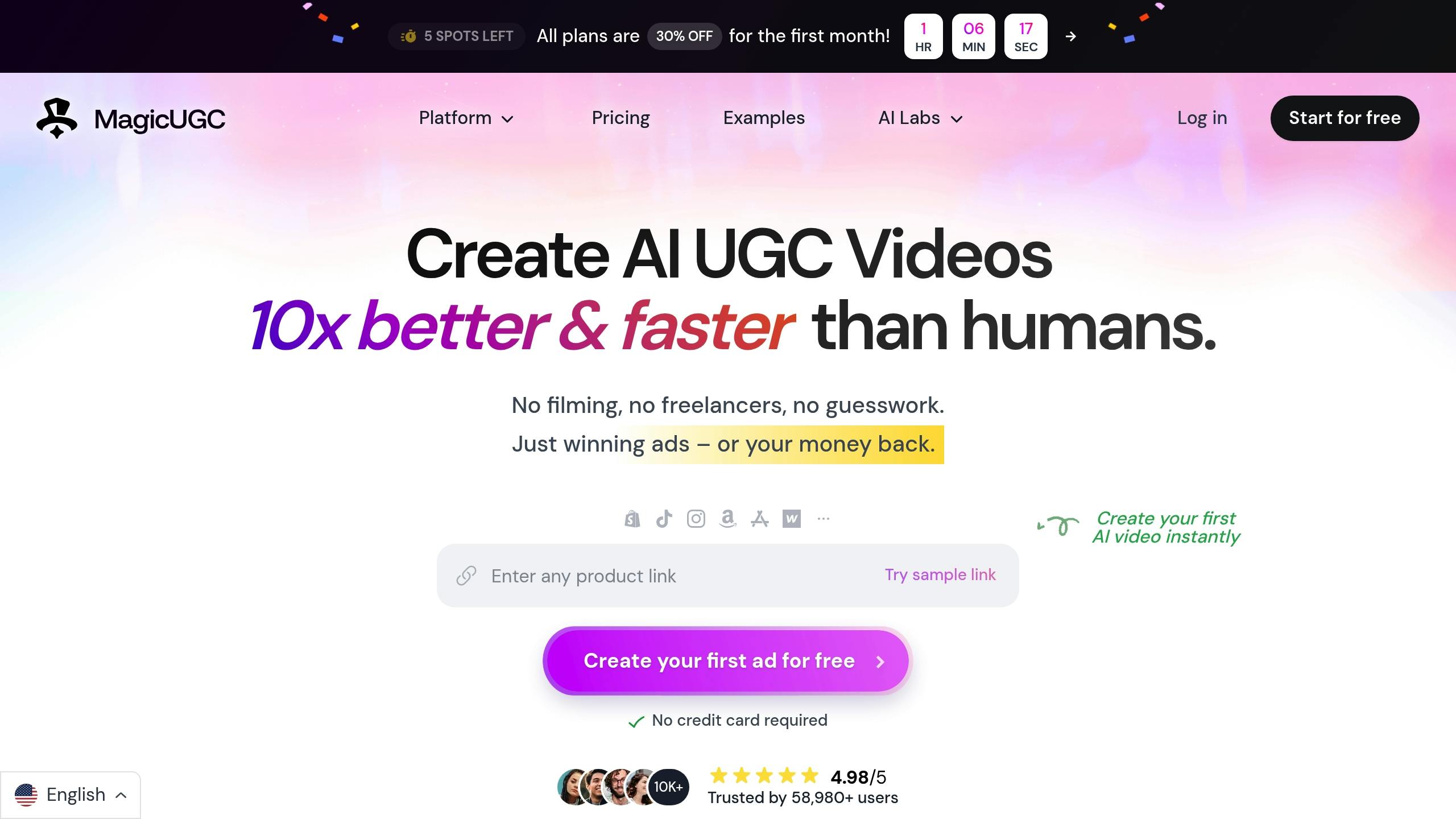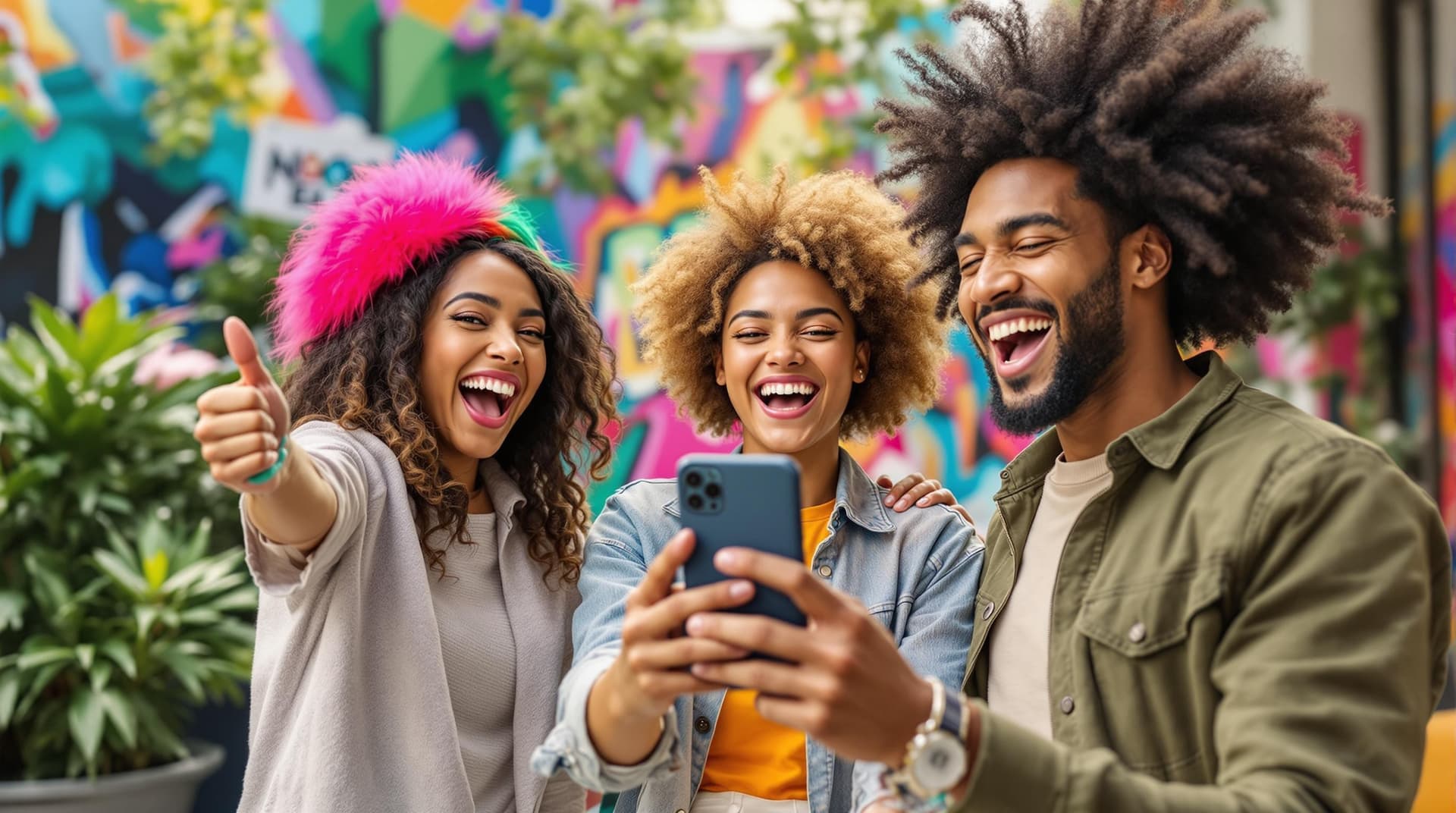
AI-powered User-Generated Content (UGC) is transforming eCommerce in 2025. Here's why it matters:
- Boosts Trust: 85% of customers trust UGC more than ads, making it key for building credibility.
- Increases Sales: Brands using AI UGC see up to 25% higher sales by providing personalized recommendations and reducing cart abandonment.
- Cuts Costs: AI can lower content creation expenses by up to 50%, replacing costly traditional methods with automated solutions.
How It Works: AI tools analyze customer data, curate relevant content, and automate distribution across platforms like social media, websites, and email campaigns.
Top Tools: Platforms like MagicUGC, Tagshop, Flowbox, and Bazaarvoice offer features like shoppable galleries, sentiment analysis, and automated content management.
Want to implement AI UGC? Start by identifying content gaps, selecting the right tools, and distributing content across multiple channels for maximum impact. AI UGC isn't just a trend - it's a must-have for competitive eCommerce strategies in 2025.
How I Make Viral UGC Ads Using AI
Key Advantages of AI UGC
Using AI-powered user-generated content (UGC) in eCommerce offers clear benefits. It boosts customer engagement, improves sales, and simplifies operations. One of the standout benefits is how it helps build trust with customers.
Building Trust with Social Proof
Trust is everything in eCommerce, and AI UGC plays a big role here by delivering relatable content that feels genuine. Research shows that 85% of customers trust UGC more than traditional ads. AI tools can analyze customer profiles and display content that matches their preferences. This approach helps shoppers see experiences from people like them, creating stronger connections and increasing their confidence to buy.
Boosting Sales
AI UGC doesn’t just build trust - it directly impacts sales. For example, a study by RaveCapture found that brands using AI-driven UGC saw a 25% increase in sales. By offering targeted social proof and personalized recommendations, AI UGC reduces cart abandonment and makes the shopping process smoother for customers.
Cutting Content Costs
AI UGC can save significant money on content creation. Traditional methods like professional photography and editing can be expensive, but AI can lower these costs by up to 50%. Tools like Tagshop, Flowbox, and Bazaarvoice use AI to efficiently manage content rights, analyze performance, and curate material. This ensures a steady stream of relevant content at a fraction of the cost of traditional methods.
Setting Up Your AI UGC System
Content Gap Analysis
Start by evaluating how your current content is performing to uncover areas where AI-driven user-generated content (UGC) can make an impact. Look at engagement metrics, customer feedback, and the types of content your audience interacts with most. AI tools can help pinpoint product categories lacking social proof or highlight where customers face hurdles during the buying process.
For example, Stackla by Nosto uses AI to analyze existing content and identify where UGC can boost engagement. Their system reviews performance data and highlights gaps that can be filled with user-generated content.
Building Your AI UGC Plan
To create a successful AI UGC strategy, align it with your business goals and audience needs. Define a clear objective - whether it's building trust, driving sales, or improving customer interaction.
| Step | Key Activities | Results |
|---|---|---|
| Discovery | Analyze customer demographics and behaviors | Gain deeper insights into your target audience |
| Tool Selection | Choose AI UGC platforms | Simplify content creation and management |
| Content Strategy | Decide on content types and distribution channels | Ensure consistent messaging across platforms |
| Implementation | Set up AI tools and train your team | Build an efficient UGC management system |
Take Flowbox’s AI-powered product recognition system as an example. It automatically tags products in user-generated images, making them instantly shoppable. This automation saves time compared to manual tagging and ensures a smoother workflow.
Once your plan is in place, the next step is to focus on distributing the content effectively.
Multi-Channel Distribution
Share AI-driven UGC across different platforms while maintaining a unified brand voice. Research shows that using AI-curated UGC across multiple channels leads to better conversion rates than sticking to just one platform.
Tailor UGC for social media, seamlessly integrate it into your website, and use it for personalized email campaigns.
Tagshop's UGC solution is a great example. It automates content distribution across various channels while keeping the brand message consistent. Their AI system also optimizes content timing and format for each platform, helping brands maximize engagement.
sbb-itb-d822133
AI UGC Tools for eCommerce
The right tools can elevate your AI UGC strategy, making it more effective and efficient.
MagicUGC

MagicUGC is an AI-driven platform designed to create social media-ready UGC videos and ads. Its AI models are trained on vast amounts of social media data, ensuring high-quality content.
| Plan | Monthly Cost | Features |
|---|---|---|
| Basic | $149 | 20 AI UGC videos, 2 AI avatars |
| Pro | $179 | 50 AI UGC videos, 5 AI avatars |
| Turbo | $249 | Unlimited videos, 10 AI avatars |
The platform also offers MagicUGC Boost™, a feature that fine-tunes content for better engagement across social platforms. With its focus on personalized content for different audiences, MagicUGC helps eCommerce brands connect with customers more effectively.
Other AI UGC Platforms
If you're exploring alternatives, here are a few other platforms that cater to specific eCommerce needs:
- Tagshop: Integrates with top eCommerce systems to create shoppable experiences from UGC. Its AI-powered tools make it easy to shop directly from social media posts.
- Flowbox: Focuses on rights management and analytics, offering detailed performance metrics and shoppable galleries for eCommerce sites.
- Bazaarvoice: Strengthens UGC strategies with tools for managing reviews, helping brands enhance customer feedback and improve product appeal.
When choosing a platform, keep these factors in mind:
- Integration with your existing systems
- AI tools for content curation
- Rights management features
- Analytics for performance tracking
- Pricing that fits your budget
Select a platform that aligns with your business goals and can scale as your UGC strategy grows.
AI UGC in 2025 and Beyond
AI-driven User-Generated Content (UGC) is reshaping eCommerce by focusing on script optimization and clear brand messaging. These elements are becoming key to engaging customers and boosting conversions.
Top-Performing Script Templates
AI script templates now prioritize personalization and emotional connections. The best-performing templates follow proven patterns that encourage interaction and drive sales:
| Template Type | Key Elements | Best Use Case |
|---|---|---|
| Product Review | Personal stories, specific benefits, before/after examples | High-ticket items |
| Tutorial/How-to | Step-by-step guides, useful tips, results | Complex products |
| Lifestyle Integration | Real-life usage, relatable moments, daily routines | Lifestyle brands |
For even better outcomes, combine AI Persona Targeting with cultural adjustments. For instance, MagicUGC Turbo Plan users benefit from advanced tools that automatically adjust tone and style based on audience demographics.
While templates are important, maintaining a consistent brand voice is equally critical for effective AI UGC.
Brand Voice Guidelines
To ensure all AI-generated content aligns with your brand, follow these strategies:
Core Voice Elements
- Define your brand's personality, tone, and visual style upfront.
Implementation Framework
- Use AI tools to analyze your top-performing content for insights.
- Develop brand-specific templates with preset tone and style guidelines.
- Set up automated checks to ensure consistency across all content.
- Use AI to replicate successful content patterns while staying true to your brand identity.
- Personalize content further by tailoring it to customer segments, regional preferences, shopping habits, and platform-specific behaviors.
Wrapping It Up
Highlights Recap
AI-powered user-generated content (UGC) is shaping the future of eCommerce in 2025. By tapping into its ability to curate and personalize content, businesses are seeing stronger customer engagement and improved sales outcomes.
Here are the key areas driving change:
- Building Customer Trust: AI identifies and highlights genuine customer content, bolstering social proof.
- Boosting Efficiency: AI tools simplify UGC management while maintaining quality.
- Improving Sales: When AI-curated UGC is shared across multiple channels, conversion rates climb.
These insights can help guide your next steps.
Practical Steps to Take
To successfully integrate AI-driven UGC into your eCommerce strategy, focus on these actions:
| Priority | Action Item | Expected Outcome |
|---|---|---|
| Immediate | Use AI to identify content gaps | Find opportunities for impactful UGC |
| Short-term | Automate UGC workflows | Simplify and speed up content management |
| Mid-term | Expand to cross-channel sharing | Reach more customers and increase engagement |
| Long-term | Develop an AI personalization plan | Deliver tailored, memorable experiences |
Start with basic AI UGC tools and gradually expand your approach. The aim should be to create meaningful connections with your audience while maintaining transparency about AI's role in your processes. Regularly reviewing performance will keep your strategy sharp and responsive to market changes.
As you move forward, balance automation with genuine customer interaction. AI can elevate your UGC efforts, but authentic relationships are the foundation of success. Always prioritize clear communication about how AI is used and commit to ethical practices to build trust and loyalty with your audience.
Resources
Tool Directory
Here’s a list of AI tools tailored for UGC in 2025:
| Platform | Strength | Best For | Standout Feature |
|---|---|---|---|
| MagicUGC | AI Video Creation | High content demands | Unlimited AI videos with 10 AI avatars |
| RaveCapture | Content Curation | Social proof strategies | AI-powered sentiment analysis |
| Flowbox | UGC for Enterprises | Large-scale operations | AI-based product recognition |
| Tagshop | Shoppable UGC | Boosting direct sales | Interactive, purchasable UGC galleries |
| Bazaarvoice | Customer Review Insights | Building consumer trust | Tools for managing authentic feedback |
Use these tools to streamline your UGC campaigns and refine your approach.
Learning Materials
Expand your knowledge with these top industry resources:
- TikTok's Business Creative Center: Weekly updates on trending UGC formats and performance metrics.
- Stackla by Nosto's AI Personalization Guide: A detailed look at AI-powered shopping experiences.
- MagicUGC's Brand DNA Scanner Documentation: A technical manual for optimizing AI-generated content.
These materials are great for staying ahead in the AI UGC space.



